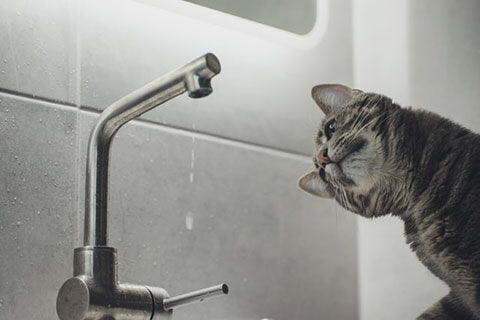Low water pressure in a bathroom faucet is a common problem that affects many households. This problem can be a real nuisance, especially if you are in a hurry. Washing your hands or brushing your teeth can be painstakingly slow. In fact, you may even think twice about using the bathroom sink faucet. Fortunately, low water pressure in a single hole bathroom faucet is a simple problem that you can fix yourself by making a few adjustments. In this post, we will discuss causes and solutions for slow water pressure from a bathroom faucet.
-
Clogged faucet aerator
Bathroom sink faucets have faucet aerators that trap debris. The faucet aerator is made of wire mesh that helps regulate the flow of water and aerate it to ensure a smooth and steady flow of water. Additionally, it also acts as filters and collects dirt and dribs at the end of the faucet. Faucet aerators can get clogged when they collect a lot of debris, thus slowing down the flow of water. The good news is that this problem is simple and can be fixed by simply removing it and rinsing it off by clean running water before reinstalling it. The screen is located at the end of the faucet. Unscrew it using a wrench then clean all components, including the mixer, flow restrictor, outer housing, and the screen before reinstalling.

-
Shut off valve
Another common cause of low water pressure in bronze bathroom faucets is the shut off valve. The primary purpose of a shutoff valve is to control the flow of water. If the shutoff valve is not fully open, the flow of water will reduce drastically. Shut off valve can fail to open completely as it is supposed to if an object knocks off the valve handle, turning it towards the off position. Locate the shutoff valves (usually located underneath the sink) to check if it is turned off. If that is the case, turn the knob counter in a clockwise direction as much as you can to see if water pressure starts to increase. If your sink has ball valves, gently turn each handle in a clockwise direction until they are parallel to the pipe.
-
Debris and mineral buildup
If you notice low water pressure in the wall-mounted bathroom sink faucet, it may be a result of debris and mineral buildup. Water contains debris and minerals that can accumulate on the pipe, thus lowering water pressure. It there is too much buildup of debris or minerals, it can clog fixture, thus reducing the flow of water. This problem is simple to fix. All you need to do is pour white vinegar on a plastic bag, hang it the bathroom faucet then allow it soak for a few hours. The vinegar will help loosen debris and mineral deposits, allowing water to flow freely as it used to.
-
Inspect for water leaks
Another common cause of low water pressure in a single hole bathroom faucet is water leaks. If water pressure is reduced, it is probably because water is leaking out of the pipe through a crack or a hole before it reaches the bathroom faucet. Please check if there are any leaks along the pipe. Detecting water leak is challenging, especially if you lack the necessary tools and experience. If you highly suspect that water leaks cause reduced water pressure, it is advised that you call a plumbing professional to check and fix the leak.
-
Broken faucet
Bathroom sink faucets are designed to last for a long time, but not forever. This means that they will break down at some point. Therefore, if the water pressure in your bronze bathroom faucet has reduced, it is probably because it is broken or too old. Although it is possible to repair broken parts, it makes more financial sense to replace the entire faucet with a brand new one. It is recommended that you call an experienced and licensed plumber to do the job for you if you decide to replace the entire bronze bathroom faucet.
-
Overall decreased water pressure.
If all sinks in your house have low water pressure, then the problem may lie with the main pipe that supplies water in your home. It may be that the main pipe is leaking or the valve is partially closed. Go outside and inspect the main pipe to see there are any water leaks. Also, locate the water shutoff valve to check if it is fully open. If there are no leakage and the water value is fully open, call your water supply company and ask if they have water pressure issues.
Conclusion
Low pressure at the wall mounted bathroom sink faucet can be caused by many factors, as discussed below. The good news is that the vast majority of these problems don’t require the attention of an expert. You only need to follow the simple tips given above. However, if the low water pressure is caused by a problem that you cannot handle or are uncomfortable handling the problem on your own with fear of creating a bigger issue that is costly to fix, it is recommended that you call a licensed plumber. They are highly skilled and well equipped to handle any plumbing problem.







